Insectivorous Plants - Part 3
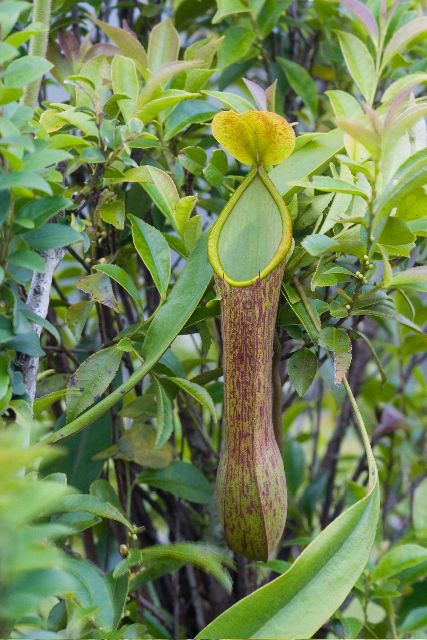
Nepenthes alata Image source
In my previous posts (Insectivorous Plants - Part 1), and (Insectivorous Plants - Part 2) I focused on the Venus flytrap (Dionaea muscipula) and sundews (Drosera spp.), both belonging to the same angiosperm family (Droseraceae). The latter family in turn is a member of the order Caryophyllales.
Another family of the order Caryophyllales that has evolved carnivory/insectivory is the family Nepenthaceae which includes the pitcher plants (Nepenthes spp.):
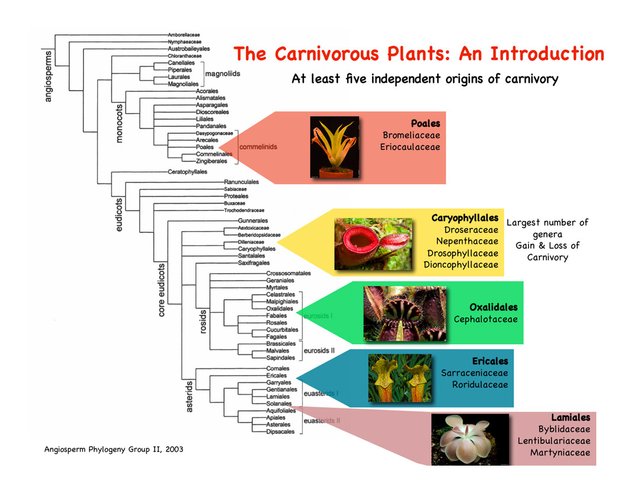
The Carnivorous Plants: An Introduction. Image from: Tanya Renner, PhD Student, University of California, Berkeley. Dissertation Research at the University of California, Berkeley
The genus Dionaea contains only one species (Dionaea muscipula) but appears closely related to the waterwheel plant (Aldrovanda vesiculosa), which in turn is closely related to Drosera spp. (Venus flytrap - Wikipedia).
The genus Drosera contains about 194 species (List of Drosera species - Wikipedia).
The genus Nepenthes contains 171 recognized species (List of Nepenthes species - Wikipedia).
see also: Carnivorous Plant Database
It is hypothesized that pitfall traps of Nepenthes and snap traps typical for Aldrovanda and Dionaea were derived from a common ancestor with adhesive flypaper traps of the Drosera type (Heubl et al. (2006)).
I encourage readers to explore the above links for images of these species, including a time-lapse video of the Venus flytrap catching prey ((Venus flytrap - Wikipedia). Images of Nepenthes spp. (List of Nepenthes species - Wikipedia) illustrate the great diversity of pitcher size and morphology in this genus.
Carnivorous plants belonging to the genus Nepenthes use specialized pitfall traps called "pitchers" that attract, capture, and digest insects as a primary source of nutrition. Nutrients derived from prey digeston are taken up by special glands localized on the inner surface of the pitchers. The pitcher glands are equipped with ammonium transporters and transport proteins for amino acids and peptides (Schulze et al. (1999)).
These glands also secrete hydrolyzing enzymes into the digestion fluid (Mithöfer (2011)). The secreted pitcher fluid contains numerous acid-stable enzymes that assist in digestion of their prey. The most abundant proteins present in the secreted fluid are proteases, nucleases, peroxidases, chitinases, phosphatases, galactosidases, gluconases, esterases and lipases (Lee et al. (2016), Rotloff et al. (2016)). Additional proteins identified in pitcher fluid include proteins related to pathogen-defense (pathogenesis-related (PR) proteins) and secretion mechanisms (Hatano et al. (2012), Lee et al. (2016)). Proteins in the pitcher fluid of the carnivorous plant Nepenthes alata (see image above) probably have two roles in nutrient supply: digestion of prey and an antibacterial effect (Hatano et al. (2012)). It appears that in Nepenthes species chitin in the exoskelton of the insect induces the phytohormone jasmonate in the pitcher glands. The jasmonate then induces expression of genes encoding digestive enzymes and subsequent synthesis and secretion of these proteins (Yilamujiang et al. (2016)). This role of jasmonate as a second messenger in coordinating digestive enzyme gene expression is similar to that described for Venus flytrap and sundews in my previous posts (Insectivorous Plants - Part 1 and Insectivorous Plants - Part 2).
Moran et al. (2012) succinctly described the major characteristics of pitcher plants and the features which aid in insect attraction and capture: "Carnivorous pitcher plants of the genus Nepenthes attract arthropod prey using a combination of color patterns, scent and nectar. Typical Nepenthes pitchers are tubular/ovoid in shape, with an opening at the top, surrounded by the peristome (the collar-shaped structure surrounding the pitcher mouth), and a lid situated above. Prey fall into these pitchers under gravity. Capture mechanisms include a wettable peristome, slippery wax crystals on the inner pitcher wall, and viscoelastic fluid." (Moran et al. (2012)).
Many Nepenthes spp. produce epicuticular wax crystals on the pitcher walls to make them slippery for the prey (Riedel et al. (2007)). But the amount of wax varies substantially between species. Trap waxiness and fluid viscoelasticity seem to be inversely related, suggesting the possibility of an investment trade-off for the plants (Bonhomme et al. (2011)). The surface profile parameters of the wax layer showed striking similarities to those of polishing paper with low grain size (Scholz et al. (2010)).
Viscoelasticity of the pitcher plants has been investigated by Gaume and Forterre (2007). The fluid is mucus- and saliva-like, preventing insect wing and leg movements. I would encourage readers to view time-lapse videos of "Prey retention by viscoelastic fluid of N. rafflesiana" available at Nepenthes - Wikipedia.
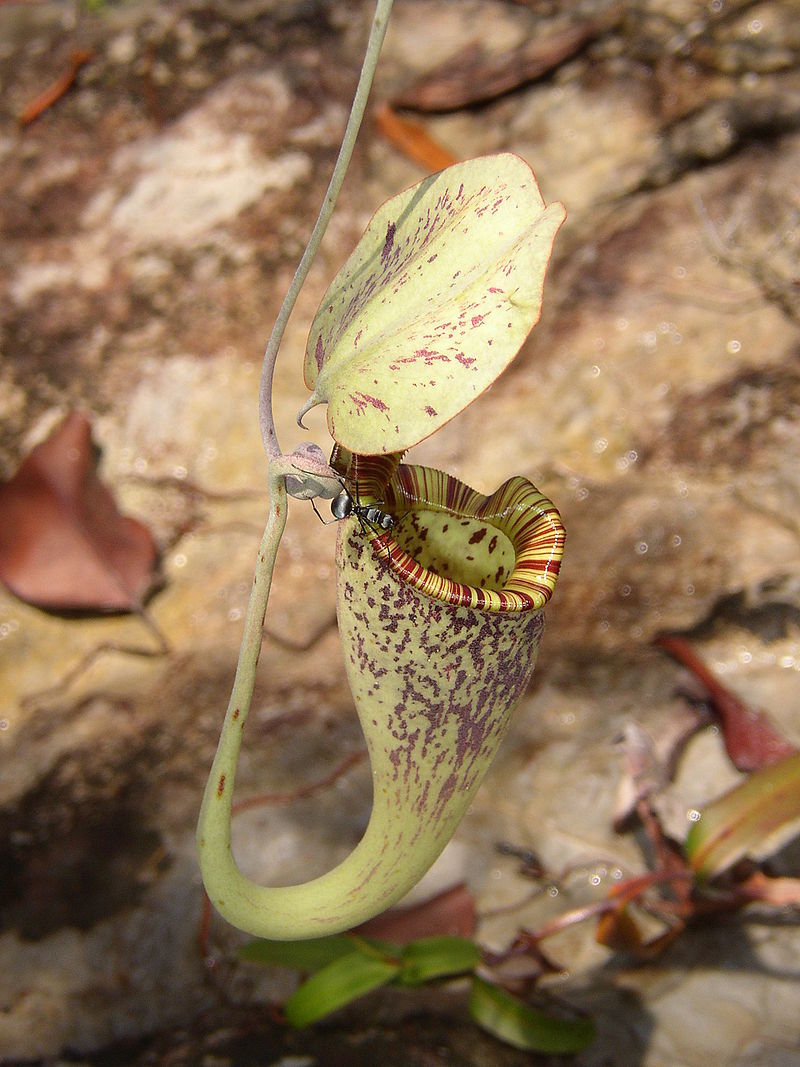
Nepenthes rafflesiana Image source
"The pitcher lid and peristome (a collar-shaped structure surrounding and overhanging the mouth) are the sites of the highest density of extrafloral nectaries. In some species, the aerial pitchers produce fragrance; this has been demonstrated to attract anthophilous (flower-visiting) insects. In addition, color patterns may serve to attract prey in some species. For example, pitchers of N. rafflesiana possess peristomes that stand out in high contrast against the pitcher body in the ultraviolet, blue and green wavebands (350–370, 430–470 and 490–540 nm, respectively). These regions correspond to insect visual sensitivity maxima, making the pitchers highly conspicuous to many anthophilous taxa. The possession of apparently floral traits (nectar, fragrance and visual orientation cues to a nectar source) by Nepenthes pitchers represents a powerful example of convergent evolution. Both insect-pollinated flowers and Nepenthes pitchers have evolved to attract and retain insects at the site of optimum benefit to the plant, the first through transfer of gametes, the second, via the acquisition of scarce nutrients." (Moran and Clarke (2010)).
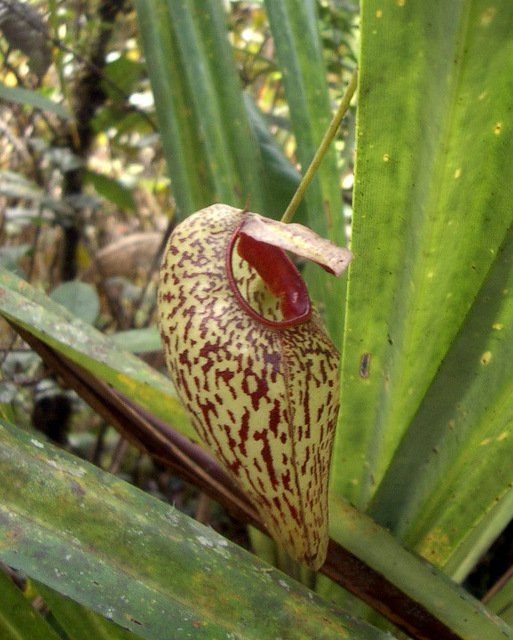
Nepenthes aristolochioides Image source
The use of light in prey capture by the tropical pitcher plant Nepenthes aristolochioides was investigated by Moran et al. (2012). This species has an unusual translucent dome. UV, blue, and green light transmitted through the translucent dome appears key to this species' trapping mechanism.
Many Nepenthes pitchers produce high levels of carbon dioxide (derived from pitcher respiration) which can attract insect prey (Baby et al. (2017)).
The wet upper rim (peristome) of certain Nepenthes species is a very effective trapping device that causes ‘insect aquaplaning’. Droplets spread instantly on this surface and form a continuous thin water film that causes insects to slip and fall into the pitcher (Bauer et al. (2012)).
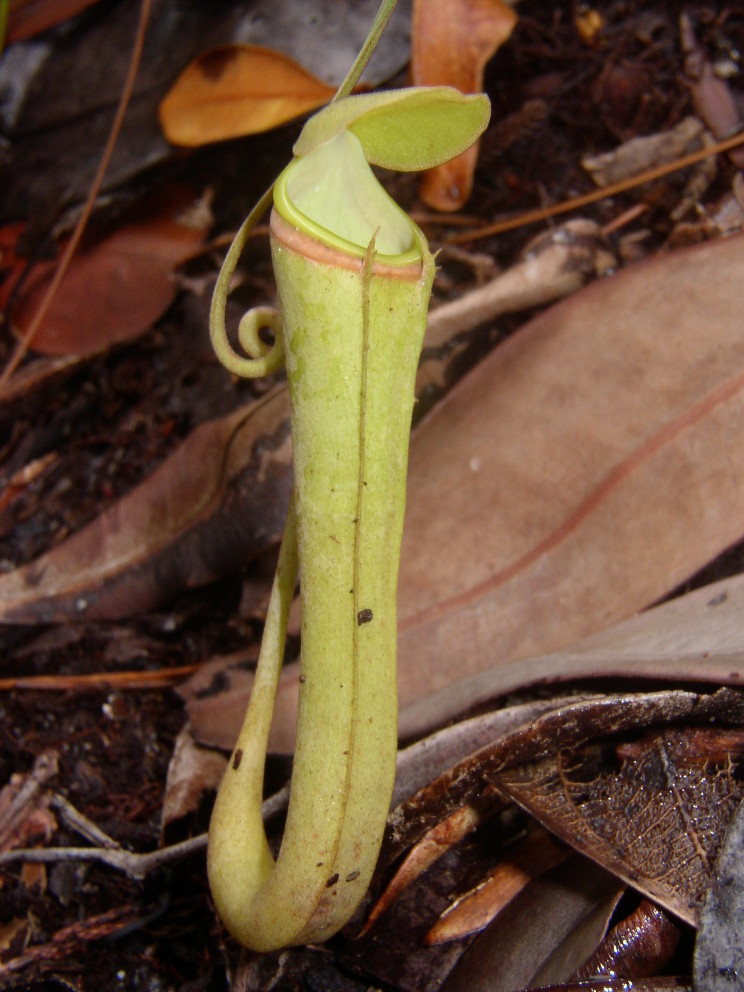
Nepenthes albomarginata Image source
Nepenthes albomarginata uses a fringe of edible white hairs (lichen-mimicking tissue) to lure and then trap its prey, which consists exclusively of termites (Merbach et al. (2002), Pavlovic (2012)).
Some Nepenthes species have pitchers that are large enough for bats to roost in them. The bats excrement contains urea which serves as a nitrogen source for Nepenthes hemsleyana (not shown). This plant utilizes the enzyme urease to break down the urea to ammonium and carbon dioxide Yilamujiang et al. (2017)). The use of animal excrement as nutrient source for these plants is termed "coprophagy".
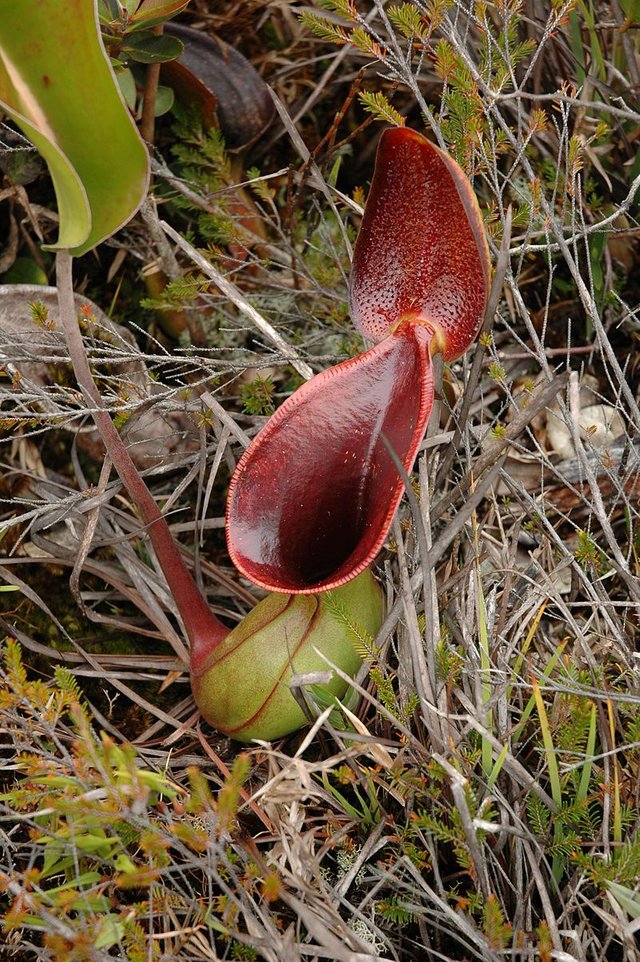
Nepenthes lowii Image source
Nepenthes lowii, from Borneo, produces two types of pitchers that differ greatly in form and function. Pitchers produced by immature plants conform to the ‘typical’ Nepenthes pattern, catching arthropod prey. However, pitchers produced by mature N. lowii plants lack the features associated with carnivory and are instead visited by tree shrews, which defaecate into them after feeding on exudates that accumulate on the pitcher lid (Clarke et al. (2009)). These have been termed "toilet pitchers" (Clarke et al. (2010)).
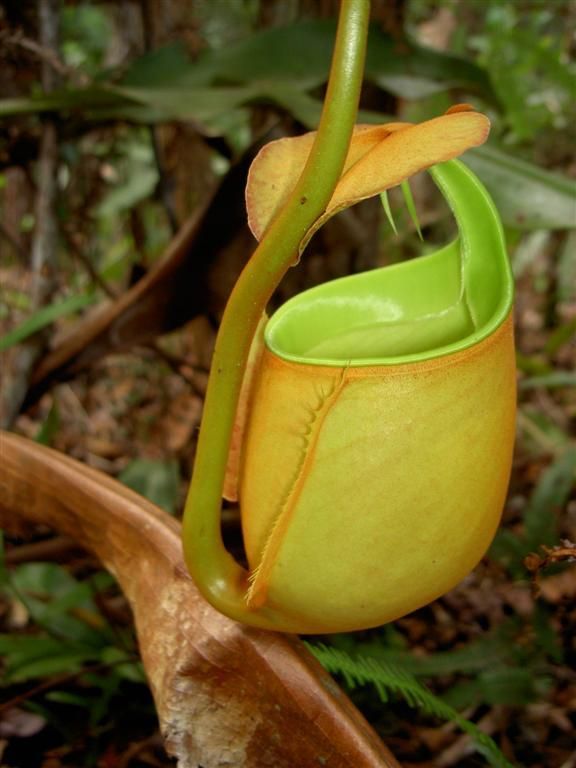
Nepenthes bicalcarata Image Source
Certain Nepenthes species have a symbiotic relationship with ants. Camponotus schmitzi ants lie in ambush under the pitcher rim of Nepenthes bicalcarata and attack insect visitors systematically once they fall into the pitcher (Bazile et al. (2012)). The ants may help catch prey, assist in digestion and protect the plant against herbivory by weevils (Pavlovic (2012)).
Nepenthes gracilis Image source
Nepenthes gracilis uses the impact of rain drops to catapult insects from the underside of the canopy-like pitcher lid into the fluid-filled trap below (Bauer et al. (2015)).
The diversity of trapping mechanism in this genus is astounding!
Please feel free to comment or ask questions below. I will try to respond as soon as possible.
Great pictures, reminds me of when I visited Kew gardens.
Thanks, but the pictures are not mine (see cited image sources). I have always wanted to go to Kew gardens, and will have to put that on my 'bucket list'.
Yes I would recommend it especially if plants are your passion.